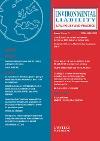Environmental Liability - Law, Policy and Practice - Volume 28 - Issue 2

Special Issue
Law and the Environment Conference 2023,
University College Cork
Environmental Law as Administrative Governance (Part I)
Editorial
Environmental governance and the climate and biodiversity crises
OWEN McINTYRE
University College Cork
Articles
An evaluation of climate adaptation policy in Britain and Ireland: what we can learn from our neighbours
DENISE McCULLAGH,
MaREI Centre, Environmental Research Institute,
University College Cork, Ireland
STEPHEN JONES
Northern Ireland Environment link, Belfast, Northern Ireland
JANE McCULLOUGH
Northern Ireland Environment link, Belfast, Northern Ireland
JADE BERMAN
National Trust, Belfast, Northern Ireland
ELLIE MURTAGH
British Red Cross, Edinburgh, Scotland
BARRY O’DWYER
KPMG, Cork, Ireland
ANNA BESWICK
Sniffer, Edinburgh, Scotland
To explore how each of the five jurisdictional areas in the UK and Ireland have adapted to the challenge of climate change the authors carried out an assessment of the adaptation policies of each of these jurisdictions evaluated against a list of essential criteria for successful adaptation, using a modified Delphi approach. The results demonstrate that while these national policies generally acknowledge the necessary aspects of good climate adaptation, they currently do not provide the resources to allow for this to be implemented. This research proposes an assessment framework that can be used to explore the role of national and regional governance in driving inclusive and sustainable adaptation, and identify how place-based and context specific factors can be overcome with proactive approaches to enable adaptation nationally or sub-nationally.
Examining states’ emissions responsibilities: assessing the strengths and weaknesses of the production-based accountability system for greenhouse gases
AHMAD ALI SHARIATI
University of Sussex
This article explores the production-based accountability (PBA) system, which is widely used to allocate responsibility for GHG emissions among states. The PBA approach attributes emissions based on the principle of territoriality, holding each state responsible for emissions occurring within its borders. However, the increase in emissions associated with global trade has raised questions about the adequacy of this method. This article discusses the advantages and disadvantages of the PBA system, including its simplicity and responsibility-sharing philosophy, along with the risks of carbon leakage and the exclusion of certain emissions embedded in trade. The analysis contributes to the ongoing debate on how best to account for and allocate responsibility for GHG emissions, ultimately aiming to promote effective climate change mitigation efforts.
Making sense of existing legal requirements to regulate emissions and removals from land use activities on peatlands in Ireland
ALESSANDRA ACCOGLI
UCD Sutherland School of Law
The article looks at how emissions and removals from land use activities on peatlands are regulated in Ireland. While peatlands act as carbon sinks when left in a natural state, they become a source of emissions once they are degraded. In light of the international and EU climate objective of achieving a balance between GHG emissions by source and removals by sinks, understanding how emissions and removals from the land use, land-use change and forestry sector (LULUCF) sector are regulated appears to be a crucial task. Considering the importance of preserving the carbon stock of peatlands, this ecosystem offers a novel case study through which to examine the LULUCF requirements, with Ireland offering an interesting example through which to explore how emissions and removals from land use activities are regulated on the ground, including an analysis of the reporting and accounting requirements for peatland emissions and removals and how these translate into practice.
Conserving at-risk species and birds in the US and the EU: a comparative summary
TEMPLE STOELLINGER
University of Wyoming
MADELINE KASS
University of Seattle
There seems little doubt that EU and US legal efforts to conserve wildlife have saved a great many individual wild animals and prevented wholesale extinction of many wildlife species. However, such conservation efforts have yet to reverse or halt trending declines. This comparison of their most significant wildlife conservation laws aims to uncover shared strengths, innovative approaches, and to encourage efforts to strengthen and improve conservation laws in the EU and US, be it through changes to the existing laws discussed here or through adoption of new approaches.
Could rights of nature be overlapping, redundant and conflicting regarding existing environmental protection? An overview of selected European domestic law frameworks
JULIÁN SUÁREZ BOHORQUEZ
University College Cork
Using working definitions and typologies of rights of nature, put together under a doctrinal and ‘law-in-context’ approach, this article analyses four selected European domestic law frameworks from Spain, France, the Netherlands and Ireland. The aim is to evaluate the effectiveness of the sampled rights of nature provisions, and to understand their role as an alternative or complement to existing environmental law.
Current Survey
European Union
MARTIN HEDEMANN-ROBINSON University of Kent, Canterbury
